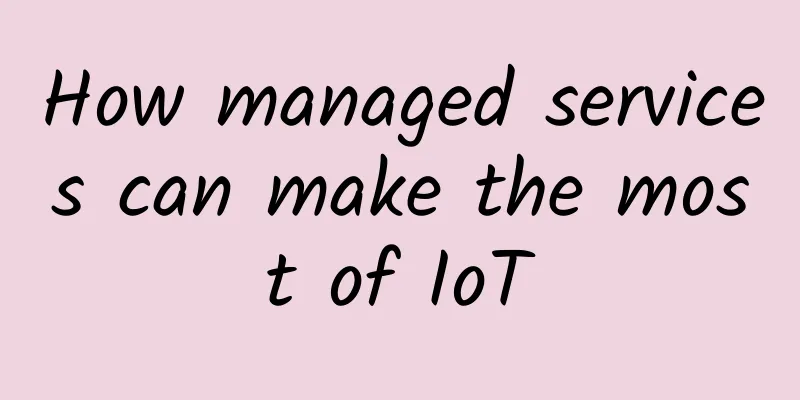How managed services can make the most of IoT

|
IoT products are everywhere—or at least they will be soon. Gartner predicts that by 2020, there will be more than 20 billion connected devices. Businesses are already recognizing the value potential that IoT brings. According to a recent survey, 82% of respondents believe they will adopt some form of IoT within the next two years, in part because they believe the information provided by IoT embedded devices will foster other innovations. But adopting IoT is not a simple matter. Currently few companies have the skills or infrastructure required to deploy IoT technology securely and efficiently.
Implementing the Internet of Things requires highly specialized skills, and nearly half of companies believe they lack these skills. This has created a widespread and troublesome skills gap - a disconnect between the demand for technology and the skills to apply it. In addition, most companies lack the necessary software, security and IT infrastructure capabilities to adopt the Internet of Things. Rather than going through the time-consuming and laborious process of acquiring these capabilities, enterprises should turn to professional service operators - those with the right expertise, experience and equipment - to extract the best value from cutting-edge IoT technologies. Managed service providers (MSPs) are well suited to fill this important role. Throughout the business world, MSPs handle complex IT deployments such as Device-as-a-Service and Managed Print Services, adding significant value to their customers. This value comes in the form of cost savings, efficient deployment, and support services, all made possible by the MSP’s familiarity with the technology they provide. MSPs have a huge incentive to acquire scarce and in-demand skills, such as IoT capabilities, in complex and cutting-edge technologies, where they have a unique economic advantage. Their business model enables them to spread the cost of knowledge acquisition across a broad customer base, making their investment cost-effective. Ultimately, this translates into savings for customers and a shift from onerous initial capital expenditures to cost-based payments. With the broad benefits of service providers who can help guide IoT projects being built now, there are three key areas that can provide specialized value to the IoT space: 1. Advanced Analytics IoT technologies will generate large amounts of precise, real-time data about how their host devices are performing. This data can be used to improve the performance and lifespan of devices. However, McKinsey found that only 1% of all IoT data collected is ever used. Clearly, businesses are not taking advantage of the data that is available. The problem is that it is too complex and easy to manipulate - it requires an understanding of big data analytics. MSPs will develop the ability to analyze and interpret this important data - using big data principles, which will be fed back to them directly from the devices they manage. Used correctly, this data can provide important insights into usage, performance and physical condition - all of which can be used to optimize devices, configure them for specific end users and predict wear and tear. These insights will greatly improve the user experience. 2. Service Innovation MSPs can also combine this new classification of device data with their existing databases of customer information. Comparing macro-level enterprise insights with micro-level usage analytics will yield a range of findings. They will also empower MSPs to develop and deliver a range of innovative and tailored services, such as preventive maintenance, product tailoring, product adjustments, improved customer service, etc., to ensure that companies and their employees get the most from their products. There are situations and sectors where new, IoT-based services can provide significant improvements. In logistics, sophisticated asset tracking will enable companies to monitor their supply chains more closely, enabling logistics and inventory optimization and achieving tighter quality control. In manufacturing, construction, and natural resources, on-site device intelligence can reduce maintenance costs and downtime through preemptive repairs. In office environments, IoT-driven customer insights can let MSPs plan the distribution of printers and personal systems to maximize productivity while minimizing expenses. IoT data patterns can reveal ways to improve business operations and efficiency. MSPs will soon be able to combine recommendations on device deployment with data-driven advisors to maximize device deployment to achieve business goals. 3. System Security New capabilities mean new vulnerabilities. And more data means more sensitive information. In a recent survey, 96% of security professionals said they expect industrial IoT vulnerabilities to grow overall this year. Large-scale distributed denial-of-service attacks against unsecured IoT devices such as network cameras, video recorders, routers, baby monitors, etc. will only increase in frequency and impact. In fact, security ranked first among Gartner's 10 IoT technologies for 2017 and 2018. Gartner said that "IoT security will be complicated because many of the 'things' use simple processors and operating systems that may not support complex security measures." Diligent MSPs will acquire the necessary know-how, or recruit a suitable expert partner, to prepare their clients for IoT-related threats. As part of an evolving suite of services, MSPs will offer security assessments, devices with built-in detection and recovery capabilities, automated security updates across systems, and proper data destruction for retired devices. MSPs will also continue to move from network security to endpoint security, and will design and deploy robust but unobtrusive security protocols. Fundamentally, this means having better system security without significant in-house expertise. The Internet of Things has changed the game in many unpredictable ways. To maximize the protection of every investment, a unique skill set and a well-thought-out deployment are required. Managed service providers will provide the intelligence, skills and experience to fully exploit the potential of IoT-connected devices while ensuring that company assets are protected. |
<<: Can the three major operators jointly develop Fetion to compete with WeChat?
>>: Compare Alipay and WeChat Pay in many aspects, which one do you prefer?
Recommend
CloudCone 6th Anniversary Promotion Starting from $21.21/year, 1GB/30G SSD/1TB/Los Angeles Data Center
CloudCone started its 6th anniversary promotion i...
Capital favor continues to rise, and 5G development will receive another 100 billion hot money in 2021
In 2019, my country's 5G commercial use was o...
RAKsmart cloud servers start at 10% off, Hong Kong/Japan/Los Angeles/San Jose cloud servers start at 129 yuan/year
RAKsmart data center has launched the "Every...
With the accelerated development of 5G technology, what challenges does the data center face?
Memory security is not a new concept, but the sur...
The Wireless Network Alliance praises Wi-Fi 6E, and the future is promising
After Wi-Fi 6, wireless networks have also ushere...
Security monitoring and observability capability building based on system operation experience
Observability refers to the ability to measure th...
How to network clock synchronization in wireless networks?
[[346597]] This article is reprinted from the WeC...
80VPS: Los Angeles VPS starts at 199 yuan per year, 8C (237 IP) cluster server starts at 800 yuan per month
80VPS is a long-established Chinese hosting compa...
When it comes to data transmission, 5G is just the beginning
If there’s a technology that’s tailor-made for th...
What happens when we enter a URL into our browser?
Preface What happens when we enter a URL into the...
5G applications are flourishing, and standard construction regulates industry development
As a representative technology, 5G has become the...
LiFi is a wireless communication technology that uses visible light communication to transmit data
Visible light communication is a technology that ...
The key to moving towards multi-cloud is management tools
Now it has become a consensus that enterprises sh...
What is the difference between 5G and 6G?
In a world where technology is constantly evolvin...
BandwagonHost has launched a new SoftBank line in Osaka, Japan, with an annual fee starting from US$65
bandwagonhost is a subsidiary of the old IT7 comp...









